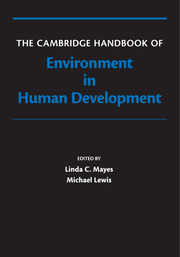Crossref Citations
This Book has been
cited by the following publications. This list is generated based on data provided by Crossref.
MIZOKAWA, Ai
and
KOMIYA, Asuka
2014.
SOCIAL ECOLOGY AND THEORY OF MIND.
PSYCHOLOGIA,
Vol. 57,
Issue. 2,
p.
133.
Hein, Sascha
Tan, Mei
Aljughaiman, Abdullah
and
Grigorenko, Elena L.
2014.
Characteristics of the home context for the nurturing of gifted children in Saudi Arabia.
High Ability Studies,
Vol. 25,
Issue. 1,
p.
23.
Mohammed, Nisreen Yacoub
and
Samak, Yasser Abdelazim Abdelmawgoud
2017.
Spoil the Rod and Save the Child: Socioeconomic Predictors of Harsh Discipline by Parents, Egyptian Case Study.
Journal of Interpersonal Violence,
Vol. 32,
Issue. 11,
p.
1730.
Fischmann, Tamara
2017.
Flucht, Migration und Trauma: Die Folgen für die nächste Generation.
p.
235.
Masten, Ann S.
and
Barnes, Andrew J.
2018.
Resilience in Children: Developmental Perspectives.
Children,
Vol. 5,
Issue. 7,
p.
98.
Ozernov‐Palchik, Ola
Norton, Elizabeth S.
Wang, Yingying
Beach, Sara D.
Zuk, Jennifer
Wolf, Maryanne
Gabrieli, John D. E.
and
Gaab, Nadine
2019.
The relationship between socioeconomic status and white matter microstructure in pre‐reading children: A longitudinal investigation.
Human Brain Mapping,
Vol. 40,
Issue. 3,
p.
741.
Snijders, Vera E.
Bogicevic, Lilly
Verhoeven, Marjolein
and
van Baar, Anneloes L.
2020.
Toddlers’ Language Development: The Gradual Effect of Gestational Age, Attention Capacities, and Maternal Sensitivity.
International Journal of Environmental Research and Public Health,
Vol. 17,
Issue. 21,
p.
7926.
Sacchi, Chiara
Facchini, Sergio
Downing, George
and
Simonelli, Alessandra
2020.
The Primary Care-Video Intervention Therapy for Growth-Vulnerable Infants. A Case Study.
International Journal of Environmental Research and Public Health,
Vol. 17,
Issue. 5,
p.
1796.
Mukherjee, Sacchidananda
and
Badola, Shivani
2021.
Public Financing of Human Development in India: A Review.
Indian Journal of Human Development,
Vol. 15,
Issue. 1,
p.
62.
Gouverneur, Philip
Li, Frédéric
Adamczyk, Wacław M.
Szikszay, Tibor M.
Luedtke, Kerstin
and
Grzegorzek, Marcin
2021.
Comparison of Feature Extraction Methods for Physiological Signals for Heat-Based Pain Recognition.
Sensors,
Vol. 21,
Issue. 14,
p.
4838.
Yang, Sarah A.
and
Wild, Lauren G.
2022.
Associations Between Grandparent Involvement and Psychological Difficulties in Adolescents Facing Family Adversity.
Journal of Child and Family Studies,
Vol. 31,
Issue. 5,
p.
1489.
Richardson, Ken
2022.
Understanding Intelligence.
Giese, Sonja
Dawes, Andrew
Biersteker, Linda
Girdwood, Elizabeth
and
Henry, Junita
2023.
Using Data Tools and Systems to Drive Change in Early Childhood Education for Disadvantaged Children in South Africa.
Children,
Vol. 10,
Issue. 9,
p.
1470.
Endevelt-Shapira, Yaara
and
Feldman, Ruth
2023.
Mother–Infant Brain-to-Brain Synchrony Patterns Reflect Caregiving Profiles.
Biology,
Vol. 12,
Issue. 2,
p.
284.
Richards, Misty C.
Ferrario, Camila A.
Yan, Ying
and
McDonald, Nicole M.
2024.
The Impact of Postpartum Depression on the Early Mother-Infant Relationship during the COVID-19 Pandemic: Perception versus Reality.
International Journal of Environmental Research and Public Health,
Vol. 21,
Issue. 2,
p.
164.
Pontoppidan, Maiken
Nygaard, Lene
Hirani, Jonas Cuzulan
Thorsager, Mette
Friis-Hansen, Mette
Davis, Deborah
and
Nohr, Ellen Aagaard
2024.
Effects on Child Development and Parent–Child Interaction of the FACAM Intervention: A Randomized Controlled Study of an Interdisciplinary Intervention to Support Women in Vulnerable Positions through Pregnancy and Early Motherhood.
International Journal of Environmental Research and Public Health,
Vol. 21,
Issue. 5,
p.
587.
Gouverneur, Philip
Badura, Aleksandra
Li, Frédéric
Bieńkowska, Maria
Luebke, Luisa
Adamczyk, Wacław M.
Szikszay, Tibor M.
Myśliwiec, Andrzej
Luedtke, Kerstin
Grzegorzek, Marcin
and
Piętka, Ewa
2024.
An Experimental and Clinical Physiological Signal Dataset for Automated Pain Recognition.
Scientific Data,
Vol. 11,
Issue. 1,
Kuo, Chih Hsin
and
Kessler, Sharon
2024.
Intergenerational Transmission of Human Parenting Styles to Human–Dog Relationships.
Animals,
Vol. 14,
Issue. 7,
p.
1038.
Nygaard, Lene
Hirani, Jonas Cuzulan
Friis-Hansen, Mette
Davis, Deborah
Nøhr, Ellen Aagaard
and
Pontoppidan, Maiken
2025.
Effects on Maternal Mental Health and Parental Functioning of an Interdisciplinary Intervention to Support Women in Vulnerable Positions Through Pregnancy and Early Motherhood: A Randomized Controlled Trial.
Healthcare,
Vol. 13,
Issue. 13,
p.
1505.
Peng, Guojie
Liang, Qiwen
Li, Siying
Li, Xin
Mu, Weiqi
and
Zhou, Mingjie
2025.
Parental Marital Quality and School Bullying Victimization: A Moderated Mediation Model of Parent–Child Attachment and Child Gender.
Children,
Vol. 12,
Issue. 7,
p.
825.

 Loading metrics...
Loading metrics...


